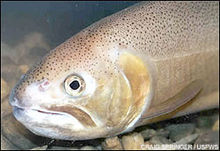- Gila trout
-
Gila trout 
Conservation status Scientific classification Kingdom: Animalia Phylum: Chordata Class: Actinopterygii Order: Salmoniformes Family: Salmonidae Genus: Oncorhynchus Species: O. gilae Binomial name Oncorhynchus gilae
(Miller, 1950)The gila trout (Oncorhynchus gilae gilae) is one of two subspecies of trout in O. gilae, the other being the Apache trout (O. g. apache). Both are native to the Southwest United States. The gila trout is a species of salmonid, related to the rainbow and cutthroat trouts. The Gila trout has been considered endangered with extinction. That changed in July 2006. Finally after much work by the Game and Fish departments in New Mexico and Arizona, the US Forest Service and the US Fish and Wildlife Service, the Gila trout was down-listed to "Threatened", with a special provision called a “4d rule” that will allow limited sport fishing – for the first time in nearly half a century. This possibility is distinct: there may be no one alive today that has legally angled a pure Gila trout from its native waters. By the time the Gila trout was closed to fishing in the 1950s, its numbers and range were so depleted and so reduced this copper-colored trout simply wasn’t all that accessible to anglers. As of 2011 there is fishing in both states for this beautiful fish.
Contents
Range
The gila trout is native to tributaries of the Gila River in Arizona and New Mexico. The gila trout is found historically in the Verde and Agua Fria drainages in Arizona. Gila trout have persisted in five streams within the Gila National Forest, New Mexico, including: Iron, McKenna, and Spruce creeks in the Gila Wilderness Area, along with Main and South Diamond creeks in the Aldo Leopold Wilderness Area.[1]
Description
Gila trout has yellow head, with black spots. The average total length is about 300.0 mm (11.8 in.); with maximum total length approximately 550.0 mm (21.7 in.).[2] Gila trout is closely related to Apache trout. However, Apache trout have a spot behind the eye, another on the head, and big noticeable spots on the body whereas Gila trout lacks the spot and is characterized by numerous small dark spots on the upper half of the body.[3]
Biology
Gila trout can be found in small mountain water streams, and in confined pools. They are opportunistic feeders that feed on terrestrial insects such as trichopterans, ephemeropterans, chironomids, and coleopterans, as well as small fishes.[4]
Reproduction
Depending on the water temperature, spawning season occurs in late spring and summer. The number of eggs produced from females held in hatcheries averaged about 150.[5] The maximum fecundity observed was 686 eggs.[6]
Conservation
The Gila trout has been threatened by competition and hybridization with introduced game fish such as the rainbow trout. However, the primary cause of reduced Gila trout populations is habitat loss caused by loss of water flow and shade-giving trees, caused in turn by fires, human destruction of riparian vegetation, livestock overgrazing, agricultural irrigation and water diversion, and channelization of streams in the Gila trout's native range. By the time the Gila trout was listed by the U.S. Fish and Wildlife Service in 1967 its range had reduced from several hundred miles of stream to just 20 in the Gila Wilderness and Aldo Leopold Wilderness.[7] After listing USFWS began an aggressive program of stream restoration, removing the introduced trout, restoring and repairing riparian vegetation (to maintain cooler water temperatures), and restocking restored streams with young Gila trout. The Mora National Fish Hatchery and Technology Center in northern New Mexico keeps brood stocks of the Gila trout and supplies the fish for restocking. The species is now more secure than it was in the 1970s, having been moved to 10 new streams, though populations and habitat are still far below those originally established.[8] Conservationists hope to eventually delist the species and allow fishing, thus forming alliances with fishermen in order to help preserve the species.
Notes
- ^ Loudeslager, E.J., J.N. Rinne, G.A.E. Gall, and R.E. David. 1986. "Biochemical genetic studies of native Arizona and New Mexico trout," The Southwestern Naturalist. 31(2): 221-234.
- ^ Behnke, R.J. and M. Zarn. 1976. Biology and management of threatened and endangered western trouts. Technical Report RM-28, Rocky Mountain Forest and Range Experiment Station, Fort Collins, Colorado. pp. 45
- ^ Sublette, J.E., M.D. Hatch and M. Sublette. 1990. The fishes of New Mexico. University of New Mexico Press, Albuquerque. pp. 57-60.
- ^ Van Eimeren, P.A. 1988. Comparative food habits of Gila trout and speckled dace in a southwestern headwater stream. Unpublished M.S. Thesis, New Mexico State University, Las Cruces. pp. 59.
- ^ Regan, D.M. 1964. Ecology of Gila trout, Salmo gilae, in Main Diamond Creek, New Mexico. Unpublished M.S. Thesis, Colorado State University, Fort Collins. pp. 57.
- ^ Sublette, J.E., M.D. Hatch and M. Sublette. 1990. The fishes of New Mexico. University of New Mexico Press, Albuquerque. pp. 57-60.
- ^ Gila Trout at Center for Biological Diversity.
- ^ Springer, Craig (27 September 2006) "Gila trout down-listed to threatened status," Fishing World
References
- Gimenez Dixon (1996). Oncorhynchus gilae. 2006. IUCN Red List of Threatened Species. IUCN 2006. www.iucnredlist.org. Retrieved on 09 May 2006. Listed as Endangered (EN B2ad+3c v2.3)
- "Oncorhynchus gilae". Integrated Taxonomic Information System. http://www.itis.gov/servlet/SingleRpt/SingleRpt?search_topic=TSN&search_value=161985. Retrieved 24 January 2006.
- Froese, Rainer, and Daniel Pauly, eds. (2005). "Oncorhynchus gilae" in FishBase. 10 2005 version.
External links
Categories:- IUCN Red List endangered species
- Oncorhynchus
- Cold water fish
- Fauna of the Southwestern United States
- Gila River
- Fish of the Western United States
- Fauna of the United States
- White Mountains (Arizona)
Wikimedia Foundation. 2010.

